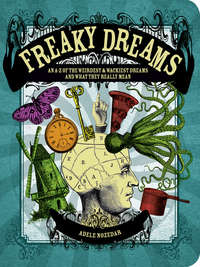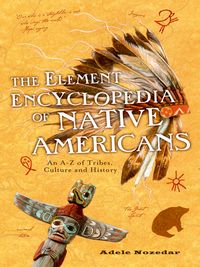
Полная версия
The Element Encyclopedia of Secret Signs and Symbols: The Ultimate A–Z Guide from Alchemy to the Zodiac
APOTROPE
This is a word of Greek origin meaning to “turn away,” and refers to a specific kind of amulet designed to ward off evil of some kind. The amulet therefore features a protective symbol, such as an eye (which wards off the evil eye, by staring right back at it), or the Hand of Fatima.
ARC
See First signs: Arc.
ARK

There are two famous arks, Noah’s Ark and the Ark of the Covenant. Both held extremely valuable objects, and so the ark symbolizes a treasure chest, a secure repository for items of secret or sacred significance. The word comes from the Latin, arca. The Greeks described the same item as a chest.
There are also two Hebrew definitions for the ark. One explains it as a wooden chest, the other as a flat-roofed building twice as long as it was high and wide. The ark could also float, and the same word is used to describe the casket that the baby Moses was found in, floating in the reeds.
In the Bible, the Ark that God commands Noah to build has a very specific set of instructions as to size, measurements, and materials used. The momentous treasure contained in this “box” was a breeding pair of every animal in the world, a genetic repository to safeguard the future of all creatures on Earth after the Deluge had washed everything else away. The Ark was God’s promise of protection to His chosen people. However, as Barbara G. Walker points out in her Woman’s Dictionary of Symbols and Sacred Objects, the scale of the Ark must have been mind-boggling if its purpose as outlined in the Bible were to be taken literally, since it would have had to hold
7,000 species of worms, 80,000 species of molluscs, 30,000 species of crustaceans, 50,000 species of arachnids, 900,000 species of insects, 2,500 species of amphibians, 6,000 species of reptiles, 8,600 species of birds, and 3,500 species of mammals, as well as food for one and all.
The Ark of the Covenant, similarly, had to be made to strictly detailed plans, as was the building that should house it. Shittim wood—the timber from the incorruptible acacia tree—was specified for the basic construction. The Book of Exodus also describes the other materials that had to be used; gold and silver, brass, blue, red, and purple silk, fine linen, goats’ hair, spices, various precious gems, red rams’ skins, and “the skins of badgers.”
Inside the Ark were stored the two Books of the Law, Aaron’s Rod, and a pot of the manna that the Children of Israel lived on during their time in the wilderness.
There is speculation about what actually happened to the Ark when Nebuchadnezzar destroyed the Temple of David in the sixth century BC. However, Jewish faith decrees that the Ark will be restored to its rightful place with the coming of the Messiah.
ARROW

Symbol of flight, penetration, and direction. As a weapon, the arrow is a symbol of the power of the person who carries it, along with the bow. As a sacred symbol, it is the attribute of the Goddess of the Hunt, Artemis/Diana, as well as of Eros, who uses his arrows to pierce the people’s hearts with love. Here, the arrow also serves as a phallic symbol and an emblem of masculine power. The symbol of the heart pierced with an arrow, popular on Valentine’s Day cards, is a covert symbol of sexual union.
The arrow as a symbol of direction works on a physical level and a metaphorical level. The arrow that shoots high up into the sky is an emblem of the link between Earth and Heaven, a symbol of an idea, or of a message being carried directly to the Gods.
The arrow is used, too, as an analogy for swiftness and sureness, since the arrow travels in the direction in which it is shot. The astrological sign of Sagittarius, the hybrid creature that is always depicted in the process of shooting an arrow from his bow, has a Latin root, sagitta; this means “arrow” and is derived from a verb, sagire, that means “to perceive keenly or quickly.” Therefore, the arrow is symbolic of quick-wittedness and intuition.
Arrows were used by the ancient Arabians, Chaldeans, Greeks, and Tibetans in a form of divination called Belomancy. This was practiced by shooting arrows in the air and reading a meaning from the direction of the arrows or their positions in relation to each other. For example, crossed or touching arrows meant “no.” Later, the arrows had words written on them to make any answers even more definitive.
ASHTAMANGALA
In Sanskrit, Ashta means “eight” and Mangala “auspicious,” and the word refers to the eight auspicious symbols of Himalayan Buddhism, although the relevance of eight sacred objects is important in the Hindu faith, too, and also in China. The Ashtamangala of the Tibetan system are, in no particular order, the Vase of Treasure, the Two Golden Fish, the Dharma Wheel, the Conch Shell, the Endless Knot, the Victory Banner, the Lotus Flower, and the Parasol. These symbols are used both in the home and in public areas and the hidden meanings of the objects are far more significant than their surface value.
THE PARASOL

Represents the sky, and is not only a symbol of protection but a sign of expansion and learning.
THE TWO GOLDEN FISH

These are also a symbol of the eyes of the Buddha, and act as a reminder to be fearless no matter what fate brings.
THE TREASURE VASE
Any representation of a vessel is as important for the space it contains as well as for any material objects it might be able to hold.

The spiritual treasures within this vase include good health and a long life, good luck, wisdom, and prosperity.
THE LOTUS FLOWER

Symbolizes purity of mind, body, action, and speech. The lotus flower rises above the metaphorical “muddy water” of attachment and desire.
THE CONCH SHELL

Because this shell can be used as a sounding horn, it acts as a reminder that followers need to be open to the sound of the Buddha’s teachings and that they need to stay awake (in a metaphorical sense), remaining aware and alert.
THE ENDLESS KNOT
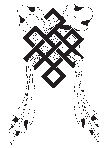
Symbolizes compassion and wisdom combined, and the need to unite spiritual and material matters.
THE VICTORY BANNER

Represents the triumph of a positive mind over seemingly negative obstacles.
THE DHARMA WHEEL

Represents the teachings of the Buddha. It is also a Mandala or Sun symbol.
ASSON
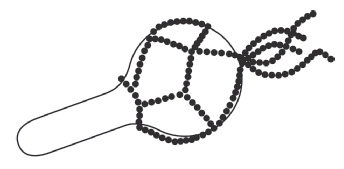
For practitioners of Voudon, the asson is a sacred rattle, made from a large dried-out gourd with seeds inside, and covered with beads and snake bones. It is used in important rites and ceremonies and is itself a symbol of the authority of the Houngan, the Voudon priest who is considered the Chief of the Spirits. The asson is the equivalent of the scepter. It is a larger object than the musical instrument called the cha cha, although they do have a similar appearance.
ASTRUM ARGENTUM SEAL
This is the seal that was designed by Aleister Crowley as the emblem of his Esoterical Magickal Order, the Astrum Argentum, or “Silver Star.” The seal uses a seven-pointed star as the basis of its design. See also Cancellarius seal.
ATHAME

This is the ceremonial knife used by a witch. It generally has a black handle, and is used to mark a magical circle, for example, or to direct energy, but is never used to cut anything. For physical cutting, a boline is used. The pointed shape of the blade of the athame suggests the element of fire, which it also symbolizes. The athame is balanced by the chalice, which represents water.
ATHANOR
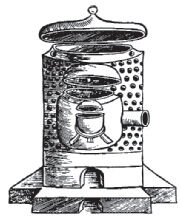
A key symbol of alchemy, the Athanor is the furnace of the Alchemists. However, as with everything else in alchemy, the Athanor is no simple piece of laboratory equipment. Regarded as the vessel in which transmutation takes place, the Athanor exists on a metaphysical level, too, as the Orphic Egg or as a place of ultimate creation, a kind of universal womb.
ATHEIST SYMBOL
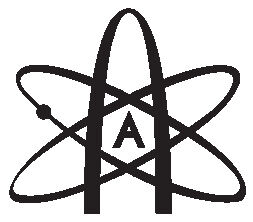
Based on the atomic swirl, this is the symbol of the American Atheist Association, although it is used by other such organizations too. It represents the idea that science is the only thing that can show the way forward to a better life for everyone. The broken loop at the bottom of the symbol represents the idea that there are questions yet to be asked and yet to be answered.
ATLANTIS CROSS
This symbol, comprised of a cross intersected by three circles, is a sign of recognition among groups who claim an Atlantean descent; that is to say, people who believe that they are descended, literally or spiritually, from inhabitants of the lost island of Atlantis. The crossed circle that forms a main feature of this symbol represents the four elements and the four directions.

AWEN
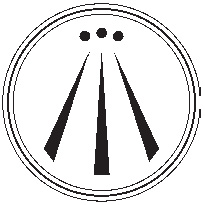
The Awen is related to many new Druid movements. The actual word, which is Welsh, means “inspiration” or “essence.” Related to the Breton symbol called the Triban and with a nod to the Trishul, the trident held by the Hindu deity, Shiva, the Awen is composed of three convergent rays, like paths, leading to a high point, a dot (or three dots) similar to the bindhu.
Each ray carries various meanings, which are equally significant and come in sets of three. They stand for past, present, and future: love, knowledge, and truth: male and female energy and the balance between the two, or the three pillars of wisdom. Another interpretation of the symbol is of the three fundamental letters of the name of God, I, O, and U, which, when pronounced contribute to the actual word “Awen,” which can be intoned in much the same way as the Aum of Eastern tradition, used as a meditative focus.
The Order of Bards, Ovates, and Druids places the three lines and the three dots within three concentric rings, further amplifying the meaning of the symbol as well as placing it within protective, magical circles.
AXIS MUNDI
Quite literally, the Axis Mundi translates as the “World Axis,” the axis around which the world revolves and which links the Heavens to the Earth and the dominions below. It is a universal concept, often defined symbolically as a tree or standing stone, a mountain, the omphalos, the lingam, the Vajra, and the Pole Star. The solstices represent the World Axis in terms of time.
BA
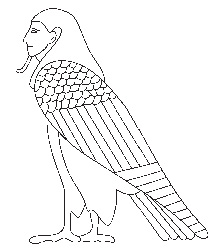
For the Ancient Egyptians, the Ba was the symbolic representation of the soul. It takes the form of a small bird with the head of a human being. The Ba could fly between its owner and the Gods for as long as the body was intact. The Ba is twinned with the Ka. If the Ba represented the soul, then the Ka was the “life-force,” the spark of life that animated the body and whose departure resulted in death. The Ka was sustained with offerings of food and drink, although it was the “ka” or spirit of the food and drink that was consumed. In the Afterlife, the Ba and the Ka would be reunited to form one single entity.
BAPHOMET
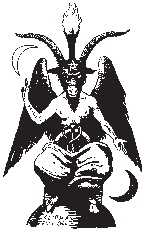
The Baphomet we recognize today is a winged goat with a masculine torso and breasts; he has a blazing torch between his horns, and cloven feet. Adding to the confusion, one arm is male and the other is female, and all in all this has become a real bogeyman of a symbol, inspiring fright and terror.
The image made its first appearance relatively recently, in Eliphas Levi’s Dogma and Rituals of High Magic (1854). Although Levi intended the creature (also called the Goat of Mendes) to be an idealized symbolic form, an amalgam of images from all disciplines including the Kabbalah, he actually created something that looks far more terrifying than he may have originally intended. The picture influenced illustrations of the Devil, not only in Tarot card illustrations but also among latter-day rock bands and, as already mentioned, among Satanists.
Baphomet himself was first described at the trials of the Knights Templar, centuries before Levi’s interpretation. When the Order began in the twelfth century, it was designed to protect pilgrims traveling to Jerusalem. Because the Knights were exempt from taxation, they amassed a huge amount of wealth and, consequently, power. When they became a threat to the establishment, they were persecuted, and part of this persecution included accusations of heresy including the worship of a peculiar looking goat-headed creature.
BECKONING CAT

A friendly little statuette with a warm welcome found all over Japan and China. What the cat is doing with his paws carries a secret message.
The cute little Maneki Neko or beckoning cat is ubiquitous in Japan and China where he appears in both homes and offices. This friendly-looking china cat can also be seen in Oriental restaurants all over the world and is for many people the ultimate symbol of prosperity and good luck.
The Maneki Neko comes in different colors, each of which signifies a different meaning. For example, a red cat will protect from illness, and a black one will ward off evil.
The position of the paws also carries a message. With the right paw raised the cat will bring money and happiness to home and workplace. A cat raising its left paw (like the one illustrated here) will attract new customers for a business. And a cat with both paws raised hits the jackpot; both home and business will be happy and profitable, attracting good luck, friends, prosperity, and new clients.
This cat is also the symbol of the small Buddhist temple in Tokyo, where the original incident that shot the cat to fame is said to have happened. Originally the temple was a lowly place, whose impoverished priest would regularly share what little food he had with his pet cat. One day some Samurai were passing and noticed this cat, who had one paw raised as though to say hello. The warriors stopped, intrigued by the beckoning cat, and went into the temple just as a horrendous rain storm started. They believed that paying attention to the cat’s invitation had prevented them being struck by lightning. Thereafter, the fortunes of the priest, the temple, and of course the cat, started to change for the better.
BELL
There is a mysticism surrounding the bell that far transcends its mundane use as a way of getting attention in the schoolroom, for example. The sound of the bell is universally accepted as a way of communicating with the spirits, or as a herald for the arrival of a supernatural, holy power.
The analogy of the bell occurs in language, too, used to symbolize something of sacred origin. In Islam, the “reverberation of the bell” is used to describe the sound of the revelations of the Qu’ran, and in Buddhism, the “sound of the golden bell” is an analogy for heavenly voices. The sound of a bell is a reminder that, like the sound, the world may be experienced, but not possessed.
Pagoda roofs sometimes have hundreds of tiny bells hanging from them, symbolizing, in sound, the concepts of the Buddhist laws as well as frightening away any malicious entities. For the same reason, the church bells of Christian churches, at one time, were peeled not only during processions or as a notice of a ceremony or service, but also during thunderstorms to chase away demons.
The bell is also a sacred object. In the form of the Buddhist Drilbu, or the Hindu Ghanta, it symbolizes the illusory world, because of the fleetingly resonant nature of its sound. It is the feminine principle paired up with the masculine vajra.
The use of these oriental bells largely influenced their European symbolism and use. The sweet reverberation of a bell, rung three times in the silence of a large stone church or cathedral, has a quality of calming the atmosphere, attracting the attention of the worshippers, welcoming in the spirits, and setting the scene for the ritual that follows.
The power of the bell as a way of spiritual communication is carried one step further in the magical bell made of an amalgam of the seven sacred metals that are ruled by the planets. This bell, engraved with the Tetragrammaton and the planetary seals from alchemy, allegedly has the power to summon the spirits of the dead. However, this spell calls for the bell to be put into a grave for seven days and seven nights before it will work properly.
BELL, BOOK, AND CANDLE
Singly, these items all have mystical significance. When grouped together, they have a certain frisson, somehow seeming to resonate with dark forces, pagan ideals, and witchcraft in particular. However, this sinister grouping actually comes from the rites of excommunication or anathema in the Roman Catholic Church. Effectively a powerful curse, this ritual is taken very seriously, reserved only for those whose transgressions against the Church are deemed unforgivable.
After the officiating cleric has verbally declared the excommunication, he declares it symbolically with three actions; he shuts the Bible, sounds the bell, and then snuffs out the candle.
These actions are clear. Closing the Bible tells the excommunicant that he is no longer privy to the Word of God. Ringing the bell is symbolic of mourning for the “departed,” the excommunicant, who is now effectively spiritually dead to the Church. Snuffing the candle is a universal sign of the “snuffing out” of the soul, now doomed because of its banishment from the faith.
BESOM
See Broomstick.
BINDHU
See First Signs: Dot.
BLACK SUN
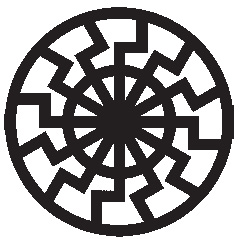
The notion of the Sun being black runs completely counter to what is generally accepted about it; the simplest explanation for a Black Sun is that it describes what happens at night, when the Sun is casting its light on another part of the planet. However, the Black Sun more sinisterly denotes the idea of the world going wrong, destructive forces, disaster, and even death.
Whether the Nazis were aware of this aspect of the Black Sun is open to conjecture. The symbol reproduced for this entry was also called the “Sonnenrad” or Sun Wheel and was based on the design of early medieval brooches, some of which had a swastika in the center. The “rays” numbered between five and twelve, with the twelve-rayed symbol denoting the passage of the Sun through the months of the year. The rays bear a great deal of resemblance to the swastika and to the lightning flash symbols used by the SS, themselves the same as a rune known as “Sig,” meaning “Sun” or “Victory.”
The symbol, used by wartime German occult mystics and still employed by some neo-Nazis, is based on a mosaic set into the floor of the early seventeenth-century castle of Wewelsburg in Germany. Himmler decided that the site of the castle would be the center of the proposed “New World” once victory was achieved. However, the extensive building works planned for the castle were never completed; the ambitious “New World” failed to materialize and the building work that had been started was blasted to the ground in 1945. The mosaic remains, although there is no concrete evidence as to who put it there. The mosaic is of dark green marble, set into a cream-colored marble floor.
For neo-Nazis, the symbol has proved a useful one. The single swastika is banned in Germany, and yet the Black Sun symbol hides three swastikas within it. Further significance is accorded the symbol since it contains twelve of the aforementioned Sig runes from the Futhark runic system. The circular shape of the symbol implies protection and magical powers. Secret signs, indeed.
BLACK SUN IN ALCHEMY
Alchemists and hermeticists believe that there are two Suns; one of the pure “philosophical gold” that implies the highest attainment of the Spirit, and the other of the baser “material gold.” The Black Sun is the symbol of this material form of the Sun, and symbolizes the unworked, primal matter that needs to be developed.


